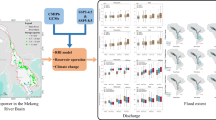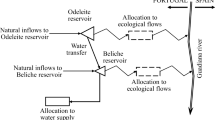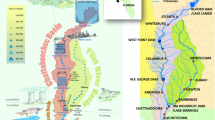Abstract
This study attempts to investigate potential impacts of future climate change on streamflow and reservoir operation performance in a Northern American Prairie watershed. System Dynamics is employed as an effective methodology to organize and integrate existing information available on climate change scenarios, watershed hydrologic processes, reservoir operation and water resource assessment system. The second version of the Canadian Centre for Climate Modelling and Analysis Coupled Global Climate Model is selected to generate the climate change scenarios with daily climatic data series for hydrologic modeling. Watershed-based hydrologic and reservoir water dynamics modeling focuses on dynamic processes of both streamflow generation driven by climatic conditions, and the reservoir water dynamics based on reservoir operation rules. The reliability measure describes the effectiveness of present reservoir operation rules to meet various demands which are assumed to remain constant for the next 100 years in order to focus the study on the understanding of the structure and the behaviour of the water supply. Simulation results demonstrate that future climate variation and change may bring more high-peak-streamflow occurrences and more abundant water resources. Current reservoir operation rules can provide a high reliability in drought protection and flood control.
Similar content being viewed by others
References
Ahmad S, Simonovic S (2000) System dynamics of reservoir operations for flood management. J Comput Civ Eng 14(3):190–198. doi:10.1061/(ASCE)0887-3801(2000)14:3(190)
Akinremi OO, McGinn SM, Cutforth HW (1999) Precipitation trends on the Canadian Prairies. J Clim 12(10):2996–3003. doi:10.1175/1520-0442(1999)012<2996:PTOTCP>2.0.CO;2
Barnett TP, Adam JC, Lettenmaier DP (2005) Potential impacts of a warming climate on water availability in snow-dominated regions. Nature 438:303–309. doi:10.1038/nature04141
Bobba AG, Lam DC (1990) Hydrological modeling of acidified Canadian watersheds. Ecol Model 50:5–32. doi:10.1016/0304-3800(90)90040-N
Burn DH, Simonovic SP (1996) Sensitivity of reservoir operation performance to climatic change. Water Resour Manag 10:463–478. doi:10.1007/BF00422550
Cayan DR, Kammerdiener SA, Dettinger MD, Caprio JM, Peterson DH (2001) Changes in the onset of Spring in the Western United States. Bull Am Metab Soc 82:399–415. doi:10.1175/1520-0477(2001)082<0399:CITOOS>2.3.CO;2
Douville H, Chauvin F, Planton S, Royer JF, Salas-Mélia D, Tyteca S (2002) Sensitivity of the hydrological cycle in increasing amounts of greenhouse gases and aerosols. Clim Dyn 20:45–68. doi:10.1007/s00382-002-0259-3
Ehrman JM, Higuchi K, Clair TA (2000) Backcasting to test the use of neural networks for predicting runoff in Canadian rivers. Can Water Resour J 25(30):279–291
Elshorbagy A, Jutla A, Barbour L, Kells J (2005) System dynamics approach to assess the sustainability of reclamation of disturbed watersheds. Can J Civ Eng 32:144–158. doi:10.1139/l04–112
Fang X, Pomeroy JW (2008) Drought impacts on Canadian prairie wetland snow hydrology. Hydrol Process 22:2858–2873. doi:10.1002/hyp.7074
Flato GM, Boer GJ (2001) Warming asymmetry in climate change simulations. Geophys Res Lett 28:195–198. doi:10.1029/2000GL012121
Gutierrez LT, Fey WR (1980) Ecosystem succession: a general hypothesis and test model of a grassland. MIT Press, Cambridge, MA
Hashimoto T, Loucks DP, Stedinger JR (1982) Reliability, resiliency and vulnerability criteria for water resource systems. Water Resour Res 18(1):14–20. doi:10.1029/WR018i001p00014
High Performance Systems, Inc. (1997) Technical Documentation—STELLA, 255 pp
Hsu KL, Gupta HV, Sorooshian S (1995) Artificial neural network modelling of the rainfall-runoff process. Water Resour Bull 25:483–490
IPCC (2007) Clim Change 2007. Synthesis report
Jakeman AJ, Hornberger GM (1993) How much complexity is warranted in a rainfall-runoff model? Water Resour Res 29:2637–2649. doi:10.1029/93WR00877
Kim SJ, Flato G, Boer G, McFarlane N (2002) A coupled climate model simulation of the last glacial maximum. Part 1: transient multi-decadal response. Clim Dyn 19(5–6):515–537. doi:10.1007/s00382-002-0243-y
Kite GW, Dalton A, Dion K (1994) Simulation of streamflow in a macroscale watershed using general circulation model data. Water Resour Res 30:1547–1559. doi:10.1029/94WR00231
Klemes V (1985) Sensitivity of water resources systems to climate variations. World Climate Problem Report WCP-98. World Meteorological Organization, pp 115
Lehning M, Volksch I, Gustafsson D et al (2006) ALPINE3D: a detailed model of mountain surface processes and its application to snow hydrology. Symposium on the Contribution from Glaciers and Snow Cover to Runoff from Mountains in Different Climates, APR 04–09, 2005 Foz do Iguacu, BRAZIL. Hydrol Process 20:2111–2128. doi:10.1002/hyp.6204
Li LH, Simonovic SP (2002) System dynamics model for predicting floods from snowmelt in North American Prairie Watersheds. Hydrol Process 16:2645–2666. doi:10.1002/hyp.1064
Moore K, Pierson D, Pettersson K et al (2008) Effects of warmer world scenarios on hydrologic inputs to Lake Malaren, Sweden and implications for nutrient loads. Hydrobiologia 599:191–199. doi:10.1007/s10750–007–9197–8
Mote PW, Hamlet AF, Clark MP, Lettenmaier DP (2005) Declining mountain snow pack in western North America. Bull Am Metab Soc 86:39–49. doi:10.1175/BAMS-86–1–39
Nakicenovic N, Alcamo J, Davis G, de Vries B, et al (2000) Special report on emissions scenarios. Cambridge University Press, Cambridge, UK
Nijssen B, O’Donnell GM, Hamlet AF, Lettenmaier DP (2001) Hydrologic vulnerability of global rivers to climate change. Clim Change 50:143–175. doi:10.1023/A:1010616428763
Salathé EP (2005) Downscaling simulations of future global climate with application to hydrologic modelling. Int J Climatol 25:419–436. doi:10.1002/joc.1125
Simonovic SP, Li LH (2003) Methodology for assessment of climate change impacts on large-scale flood protection system. Water Resour Plann Manage, ASCE 129(5):361–372
Simonovic SP, Li LH (2004) Sensitivity of the Red River Basin flood protection system to climate variability and change. Water Resour Manag 18:89–110. doi:10.1023/B:WARM.0000024702.40031.b2
Smith RE, Veldhuis GF, Mills GF, Eilers RG et al (1998) Terrestrial ecozones, ecoregions, and ecodistricts, an ecological stratification of manitoba’s natural landscapes. Technical Bulletin 98–9E. Land Resource Unit, Brandon Research Centre, Research Branch, Agriculture and Agri-Food Canada, Winnipeg, Manitoba
Stewart I, Cayan DC, Dettinger MD (2004) Changes in snowmelt runoff timing in Western North America under a ‘business as usual’ climate change scenario. Clim Change 62:217–232. doi:10.1023/B:CLIM.0000013702.22656.e8
Thomas RB, Megahan WF (1998) Peak flow responses to clear-cutting and roads in small and large basins, Western Cascades, Oregon: a second opinion. Water Resour Res 34:3393–3403. doi:10.1029/98WR02500
Vicuna S, Dracup JA (2007) The evolution of climate change impact studies on hydrology and water resources in California. Clim Change 82(3–4):327–350. doi:10.1007/s10584-006-9207-2
Water Resources Branch (1992) Shellmouth reservoir study: preliminary study of spillway control gates. Manitoba Department of Natural Resources, Canada
Water Resources Branch (1995) Assiniboine river flooding & operation of Shellmouth Dam. Report of the Shellmouth Flood Review Committee. Manitoba Department of Natural Resources, Canada
Widmann M, Bretherton CS, Salathé EP (2003) Statistical precipitation downscaling over the northwestern United States using numerically simulated precipitation as a predictor. J Clim 16:799–816. doi:10.1175/1520-0442(2003)016<0799:SPDOTN>2.0.CO;2
Author information
Authors and Affiliations
Corresponding author
Rights and permissions
About this article
Cite this article
Li, L., Xu, H., Chen, X. et al. Streamflow Forecast and Reservoir Operation Performance Assessment Under Climate Change. Water Resour Manage 24, 83–104 (2010). https://doi.org/10.1007/s11269-009-9438-x
Received:
Accepted:
Published:
Issue Date:
DOI: https://doi.org/10.1007/s11269-009-9438-x




